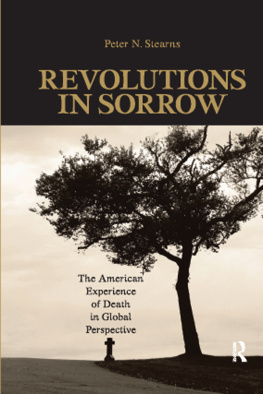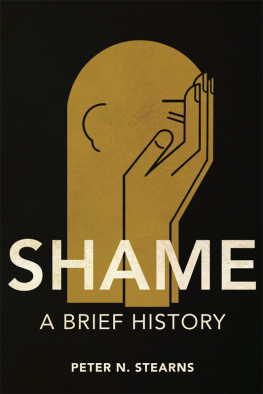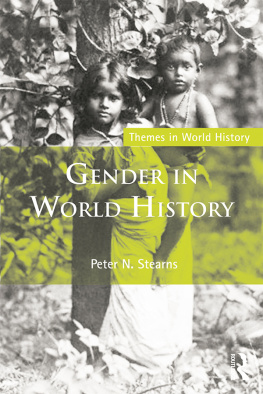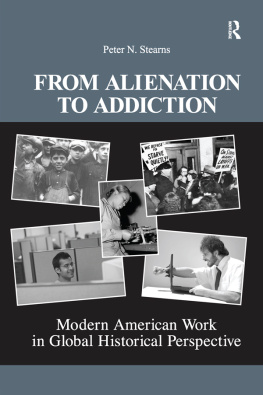Revolutions in Sorrow
U.S. History in International Perspective
Editors: Peter N. Stearns and Thomas W. Zeiler
EDITORIAL ADVISORY BOARD
Donna Gabaccia, University of Minnesota
James Gump, University of San Diego
Dirk Hoerder, Arizona State University and Universitt Bremen
Peter Kolchin, University of Delaware
Rob Kroes, University of Amsterdam and University of Utrecht
NOW AVAILABLE
Revolutions in Sorrow: The American Experience of Death in Global Perspective, by Peter N. Stearns
Revolutions in Sorrow
The American Experience of Death in Global Perspective
by Peter N. Stearns
First published 2007 by Paradigm Publishers
Published 2016 by Routledge
2 Park Square, Milton Park, Abingdon, Oxon OX14 4RN
711 Third Avenue, New York, NY 10017, USA
Routledge is an imprint of the Taylor & Francis Group, an informa business
Copyright 2007, Taylor & Francis.
All rights reserved. No part of this book may be reprinted or reproduced or utilised in any form or by any electronic, mechanical, or other means, now known or hereafter invented, including photocopying and recording, or in any information storage or retrieval system, without permission in writing from the publishers.
Notice:
Product or corporate names may be trademarks or registered trademarks, and are used only for identification and explanation without intent to infringe.
Library of Congress Cataloging-in-Publication Data
Stearns, Peter N.
Revolutions in sorrow : the American experience of death in global perspective / by Peter N. Stearns.
p. cm.
Includes bibliographical references and index.
ISBN 978-1-59451-454-8 (hc)
ISBN 978-1-59451-455-5 (pbk)
1. DeathSocial aspects. 2. DeathSocial aspectsUnited States 3. DeathSocial aspectsCross-cultural studies. 4. Social change I. Title.
HQ1073.S74 2007
306.90973dc22
2007015264
Designed and Typeset by Straight Creek Bookmakers.
ISBN 13 : 978-1-59451-454-8 (hbk)
ISBN 13 : 978-1-59451-455-5 (pbk)
For D L K, with love
Contents
A number of research assistants contributed to this project: My thanks to Veronica Fletcher, Clio Stearns, Leah Lehman, and Mahati Gollamudi. Brian Platt provided useful suggestions. A reader of the manuscript offered valuable comments as well as encouraging enthusiasm, and Leslie Lomas, of Paradigm Publishers, was unusually helpful. Alicia Smallbrock rendered vital assistance in manuscript preparation.
This series offers a new approach to key topics in American history by connecting them with developments in other parts of the world and with larger global processes. Its goal is to present national patterns in mutual interaction with wider trends.
The United States has functioned in international context throughout its history. It was shaped by people who came from other countries. It drew political and cultural inspiration from other places as well. Soon, the nation began to contribute a variety of influences to other parts of the world, from new trade patterns to the impact of successful political institutions.
It is increasingly clear, however, that the field of U.S. history has not usually captured this perspective. National developments have been treated as significant but relatively isolated events. Distinctive American characteristicssometimes systematized into a larger pattern called American exceptionalismhave been assumed but not tested through real comparison. Even the nations growing role in world affairs has sometimes taken a back seat to domestic concerns. This kind of narrowness is inaccurate and unnecessary; it feeds a parochialism that is out of keeping with the global presence of the United States. A nation cannot be understood without placement in the perspective of other nations and transnational factors.
At a time when international developments play an increasing and incontestable role in any nations affairs, the need for a new approach to national history becomes inescapable. This certainly applies to the United States. Calls for internationalizing the U.S. history survey course reflect this realization. The calls are welcome, but we need to translate them into accessible treatments of key topics in U.S. historyfrom obvious diplomatic and military initiatives to less obvious themes that in fact involve global interactions as well, themes that go deeply into the nations social and cultural experience.
The project of internationalizing American history involves drawing a variety of connections. This series will compare American developments to patterns elsewhere to see what is really distinctive, and why, and what is more widely shared. Influences from other places, from technological innovations to human rights standards, factor in as well. The U.S. impact on other parts of the world, whether in the form of new work systems, consumer culture, or outright military intervention, constitutes a third kind of interconnection.
The resultand the central goal of this seriesis to see American history in a revealing new light, as part of a network of global interactions. Wider world history gains from this approach as well, as comparisons are sharpened by the active inclusion of the United States, and American influences and involvements are probed more carefully.
Overall, a global window on the domestic interiors of U.S. history complicates conventional understandings, challenges established analyses, and brings fresh insights. A nation inextricably bound up with developments in every part of the world, shaping much of contemporary world history as well, demands a global framework. This series, as it explores a variety of topics and vantage points, aims to fill this need.
I n his novel No Longer at Ease, the Nigerian author Chinua Achebe describes the following crisis: Obi, raised in a village but now prospering as a white-collar worker in the city of Lagos in the 1920s, has come to enjoy his work routine and lifestyle, including regular dances and a fair amount of womanizing. Then his mother dies. He sends money back for the funeral, but, due to his job and his dating schedule, he just does not have time to go himself. To the villagers, his behavior is a thing of shamefor he should have gone home not just for the funeral but for an extended period of mourning. As one old man put it: This boy that we are all talking about, what has he done? He was told that his mother died and he did not care. It is a strange and surprising thing.1
In the United States, books on manners and etiquette from the late nineteenth to the early twentieth centuries had elaborate sections designed to show the proper courtesy toward a family that had just suffered a death. Visits, leaving cards to show concern, and assurances of sympathy were vital in a society in which death remained common and in which carefully prescribed etiquette was an important part of respectable life. By the 1940s, however, etiquette books changed dramatically: The emphasis changed to assert that a grieving individual must not impose on others. Extensive discussion of a loss through death was considered rude, and friends and acquaintances were not expected to put up with too much. By this point, psychologists were increasingly identifying part of their practice as grief work, in which individuals who could not easily get over a death gained professional help to get their emotions under control. The social context for death had been virtually stood on its head. The issues were not the same as those in Africa, although there was some connection; the larger point was the apparent necessity, in otherwise very different contemporary societies, to reconsider basic aspects of the ways death should be approached. Fundamental changes were occurring in accepted encounters with death, from urban Nigeria to the suburban United States.2











